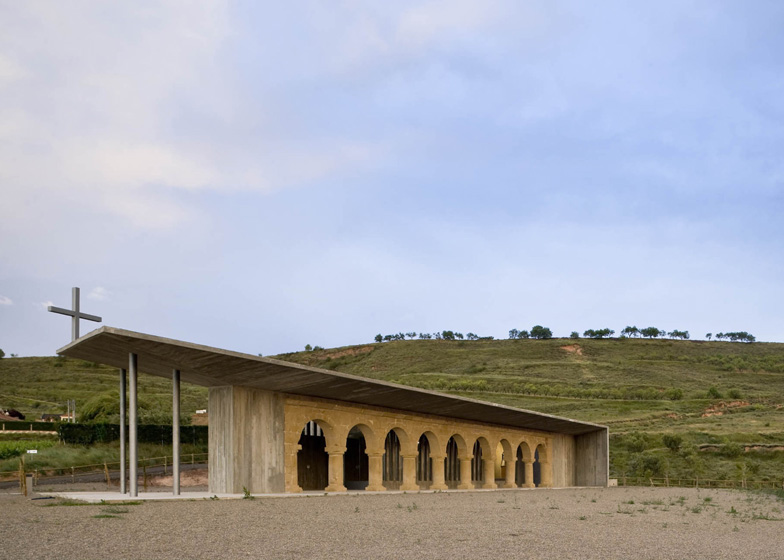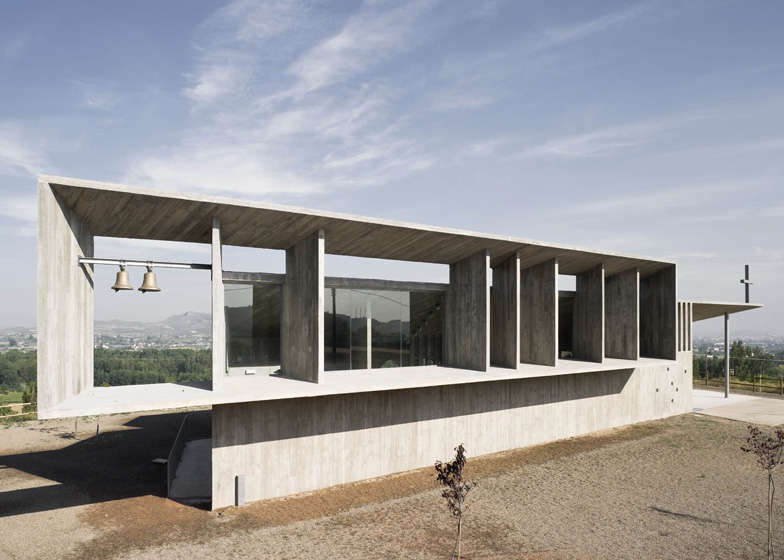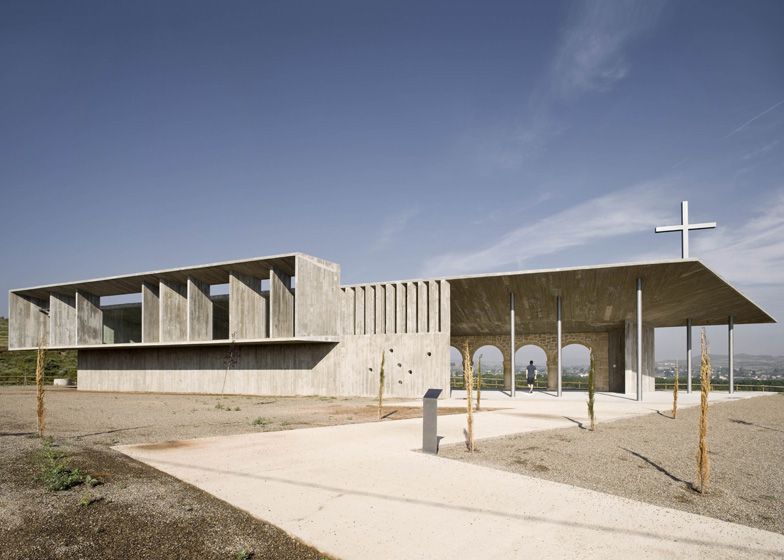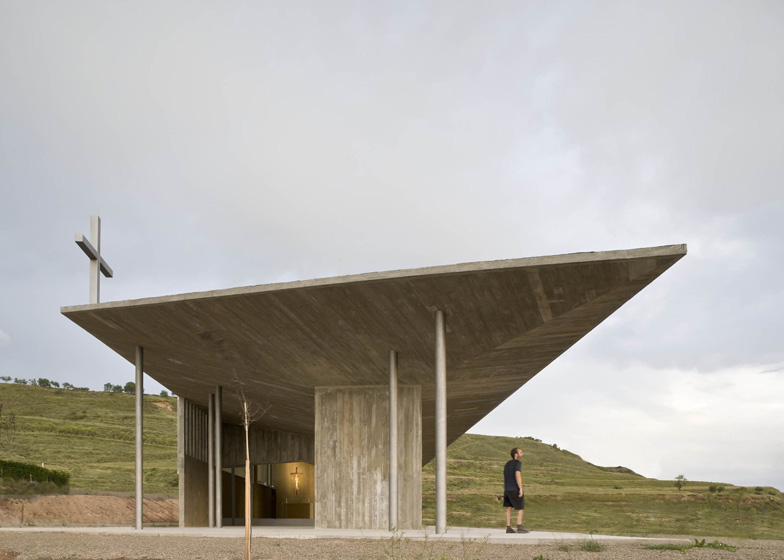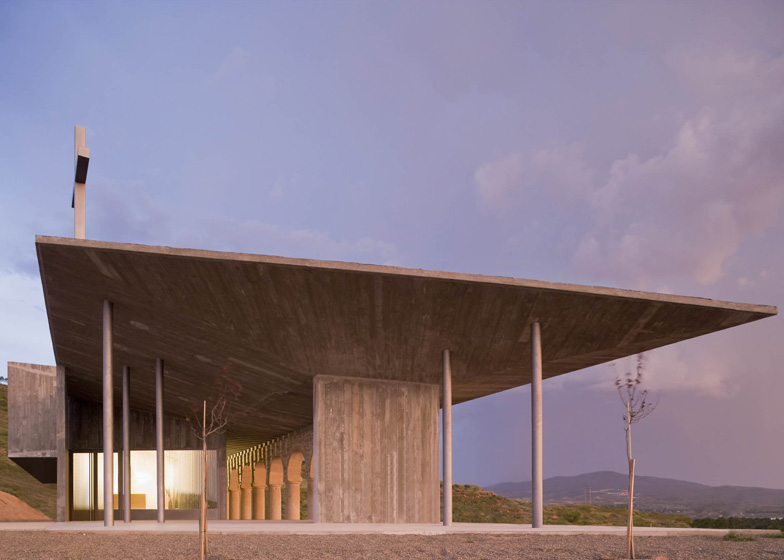A rescued stone colonnade stands amongst planes of concrete at this religious shrine in the Spanish countryside by Pamplona studio Otxotorena Arquitectos (+ slideshow).
Located outside the small village of Alberite, the Shrine of the Virgin of La Antigua stands alone on a hillside, offering wide-stretching views out across the nearby ravine.
Otxotorena Arquitectos designed the structure to accommodate both large parties and individual worship, as the shrine is only likely to attract groups of visitors at certain points on the religious calendar.
A tapered concrete canopy oversails the historic colonnade, which was rescued from near demolition by members of the local community. Concrete supports stand at either end to hold it firmly in place.
"The building volume is conceived considering the idea of framing the archway by building a parallel roof and floor to wrap and protect it," explain the architects.
A secluded chapel is sheltered beneath the roof at the rear of the structure. Behind this, an irregular framework of concrete louvres shades a length of clerestory glazing and overhangs the end of the building to create a small belfry.
Other examples of isolated religious spaces include a stark concrete church on the side of a Chinese mountain and a see-through church in the countryside in Belgium. See more places of worship on Dezeen.
Photography is by Pedro Pegenaute.
Here's some more information from Otxotorena Arquitectos:
Shrine of the Virgin of "La Antigua" in Alberite, La Rioja
The site corresponds to a plot on the outskirts of the town of Alberite. This is a 2.000 people village, very close to Logroño in La Rioja, Spain. The place is located on a gentle hill, overlooking a ravine opened into the road running through it. This was a plot of land given to the Parish by the Town Council for the construction of the shrine of the Virgin.
Above: context plan - click for larger image
First of all, the project aims to fulfill all the program requirements, concerning the nature and typical use given to this type of buildings, which, in its immediate environment, serve both for private devotional practices as well as for popular traditional temple fairs. This is a key ingredient in the way of considering the design, since we are obliged to expect a large influx of people within isolated intervals.
Above: location plan - click for larger image
On the other hand, the design also takes into consideration the characteristics of the place in terms of geometric, orientation and topographical measurements. It is also characterized by the appeal and width of its views.
Above: floor plan - click for larger image
Finally, there is added an absolutely fundamental premise: the need to incorporate a preexisting stone archway in the design. This archway was rescued from a previous demolition in the town and it was preserved by the locals. This way, it is intended to re-use the archway and to put more value on it. It was obviously called to assume a main role in the shape and perception of the building from the beginning.
Above: sections - click for larger image
When applying this set of arguments, however, we can remark some of the closely related choices chained to outline the design process:
a) The basic choice of the creation of a relatively wide outdoor space, which provides the interior of the shrine with some anteroom, protects the visitors from sun and rain and frames the view.
b) The attention given to the impact the building will cause in the landscape, even noticeable at long distances, that consists on a horizontal gesture correlative to the extent of the slope overlooking the ravine it faces.
c) The care given to the relationship between the few spaces created, both external and internal, as well as the hierarchical location of the entrances to the site and confined spaces of the chapel.
Above: sections - click for larger image
The building volume is conceived, in any case, considering the idea of framing the archway by building a parallel roof and floor to wrap and protect it.
Above: elevations - click for larger image
For its construction we are to use a single material, concrete, for immediacy and simplicity reasons, considering its suitable conditions of abstraction, continuity, stability and robustness.
Above: elevations - click for larger image

